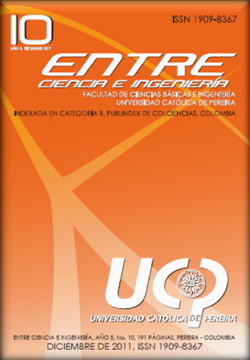Dynamic Channel Selection in IEEE 802.15.4 Using Artificial Neural Networks
Keywords:
IEEE 802.15.4, dynamic channel selection,, artificial neural networksAbstract
IEEE 802.15.4 is a communication standard for wireless personal areanetworks, the operation bands are 800, 900 and 2400 MHz. The 2400 MHzband is assigned for industrial, scientific and medical applications, and itis shared with other wireless technologies like IEEE 802.11b, 802.15.1,802.15.3 and 802.16. So, it is expected that IEEE 802.15.4 devices haveto operate close to other wireless devices, it is called coexistence. It meansthey have to present a good performance in presence of changes andinterference in radio environment.For that reason, designers and implementers of IEEE 802.15.4 devicesmust conceive mechanisms of dynamic operating that improve thecoexistence. In this way, this article proposes to use artificial neural networksfor a dynamic cannel selection for IEEE 802.15.4 like a mechanism ofcoexistence in the 2400 MHz band.
References
Chen, B., et al. (2010). “Efficient Error Estimating Coding: Feasibility and Applications”. SIGCOMM’10.
Chowdhury, k., et al. (2005). “DCA –A Distributed Channel Allocation Scheme for Wireless Sensor Networks”. IEEE 16th International Symposium on Personal, Indoor and Mobile Radio Communications.
Gavini, C. (2007). “Quantifying Tradeoffs in the IEEE 802.15.4 Protocol through Simulation”. EE464 Senior Design Project.
Haykin, S. (1999). Neural Networks. A Comprehensive Foundation (2 ed.). Pearson Education.
Hebb D. (1949). The Organization of Behavior: A Neuropsychological Theory. New York: Wiley.
Hoppfield, J. (1982). “Neural Networks and Physical Systems with Emergent Collective Computational Abilities”. En Proceedings of the National Academy of Sciences of the United States of America, tomo 79, pág. 2554-2558.
IEEE (2006). “IEEE 802.15.4, Wireless Medium Access Control (MAC) and Physical Layer (PHY) Specifications for Low-Rate Wireless Personal area Networks (LR-WPANs)”. IEEE Computer Society.
Ko, J. & Mishra, A. (2010). “DynaChannAl: Dynamic Channel Allocation with Minimal End-to-end Delay for Wireless Sensor Networks”. Johns Hopkins University. Baltimore.
Levenberg, K. (1944). “A Method for the Solution of Certain Problems in Least Squares”. Quart. Appl. Math. 2, pág. 164-168.
Marquardt, D. (1963). “An Algorithm for Least Squares Estimation on Nonlinear Parameters”. SIAM J. APPL. MATH. 11, pág. 431- 441.
McCulloch, W. & Pitts, W. (1943). “A Logical Calculus of the Ideas Immanent in Nervous Activity”. Bulletin of Mathematical Biophysics 5, pág. 115-133.
Minsky, M. & Pappert, S. (1969). “Perceptrons: An Introduction to Computational Geometry”. The MIT Press.
Rosenblatt, F. (1962). Principles of Neurodynamics: Perceptrons and the Theory of Brain Mechanisms. Washington DC: Spartan.
Rumelhart, D., Hinton, G. & Williams, R. (1986). Parallel Distributed Processing: Explorations in the Microstructure of Cognition. The MIT Press, Cambridge, MA.
Widrow, B. (1959). “Adaptive Sampled-data Systems – a Statistical Theory of Adaptation”. En IRE WESCON Convention Record, tomo 4, pág. 74-85.
Widrow, B. & Hoff, M. (1960). “Adaptive Switching Circuits”. En IRE WESCON Convention Record, tomo 4, pág. 96-104.
Won, C., et al. (2005). “Adaptive Radio Channel Allocation for Supporting Coexistence of 802.15.4 and 802.11b”. IEEE 62nd Vehicular Technology Conference.








 Revista Entre Ciencia e Ingeniería
Revista Entre Ciencia e Ingeniería .png) entrecei@ucp.edu.co
entrecei@ucp.edu.co.png) ISSN (Impreso) 1909-8367 - ISSN (En Línea) 2539-4169
ISSN (Impreso) 1909-8367 - ISSN (En Línea) 2539-4169 Attribution-NonCommercial 4.0 International (CC By-NC 4.0)
Attribution-NonCommercial 4.0 International (CC By-NC 4.0)
.png) Carrera 21 No. 49-95 Av. de las Américas, Pereira, Risaralda, Colombia
Carrera 21 No. 49-95 Av. de las Américas, Pereira, Risaralda, Colombia